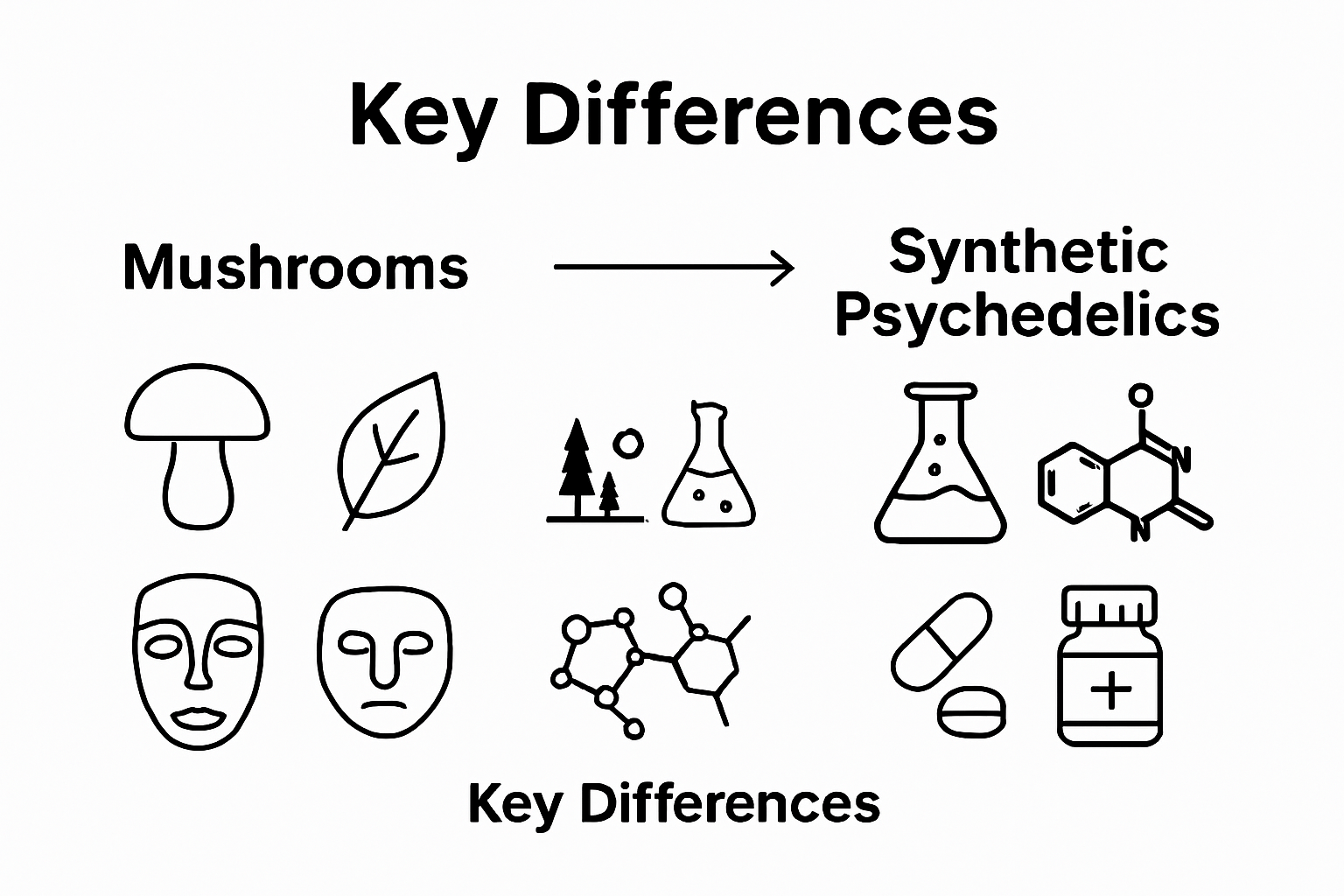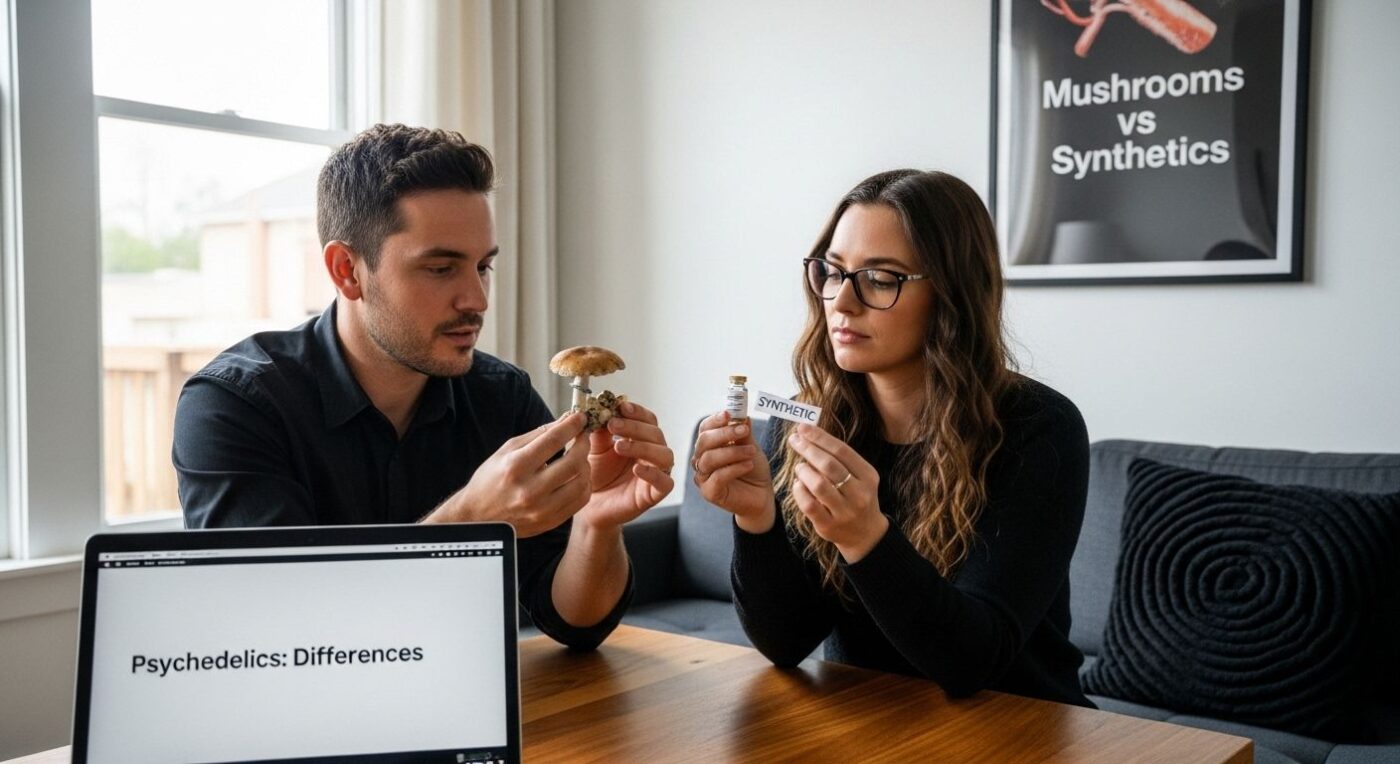Blog
Mushrooms vs Synthetic Psychedelics: Understanding the Differences
Psychedelic mushrooms and lab-made compounds are reshaping how we think about consciousness and mental health. Surprising as it sounds, studies show that psilocybin mushrooms have been used by humans for thousands of years, while their synthetic counterparts like LSD are barely a century old. But what really changes the game is not just the time gap or origin—it’s the fact that each path leads to dramatically different experiences and effects, even when the science behind them seems so closely linked.
Table of Contents
- Defining Mushrooms And Synthetic Psychedelics
- The Science Behind Psychedelics: How They Affect The Brain
- Exploring Natural Vs Synthetic Origins: Why It Matters
- Safety, Risks, And Legal Considerations In Psychedelic Use
- Cultural Context And Historical Use Of Psychedelics
Quick Summary
| Takeaway | Explanation |
|---|---|
| Psychedelic mushrooms are naturally occurring. | They grow organically in various ecosystems and have cultural significance. |
| Synthetic psychedelics are lab-engineered. | These compounds are created to produce specific neurological effects but have more standard interactions. |
| Both types affect serotonin receptors. | They interact with the 5-HT2A receptor, leading to altered brain connectivity and unique experiences. |
| Cultural practices shape psychedelic use. | Indigenous cultures have historically used psychedelics for spiritual and healing purposes, influencing contemporary understandings. |
| Consider safety and legal implications. | Understanding the legal status and personal health risks is crucial before exploring psychedelics. |
Defining Mushrooms and Synthetic Psychedelics
Psychedelic substances represent a fascinating intersection of nature and chemistry, with mushrooms and synthetic compounds offering distinct pathways to altered consciousness. While both categories influence human perception and neurological processes, their origins, chemical structures, and mechanisms differ significantly.
Natural Origins: Psychedelic Mushrooms
Psychedelic mushrooms, primarily psilocybin-containing species, emerge naturally in diverse ecological environments. These organisms have existed for millions of years, with indigenous cultures utilizing them in spiritual and medicinal practices. Research from Johns Hopkins indicates that psilocybin mushrooms contain complex molecular structures that interact uniquely with human brain receptors.
Key characteristics of psychedelic mushrooms include:
- Organic growth in various global ecosystems
- Naturally occurring chemical compounds
- Genetic variations across different species
- Traditional cultural significance
Synthetic Psychedelics: Laboratory Creations
Unlike their natural counterparts, synthetic psychedelics are carefully engineered chemical compounds produced in controlled laboratory settings. These substances are designed with precise molecular configurations to generate specific neurological responses. Compounds like LSD and MDMA represent deliberate scientific attempts to understand and manipulate consciousness through chemically synthesized molecules.
The primary distinctions between mushrooms and synthetic psychedelics center on their production methods, molecular complexity, and predictability of effects. While natural mushrooms offer variability in potency and experience, synthetic variants provide more standardized interactions.
To help you clearly see the main differences between psychedelic mushrooms and synthetic psychedelics, the following table summarizes their key characteristics, as described in the article.
| Feature | Psychedelic Mushrooms | Synthetic Psychedelics |
|---|---|---|
| Origin | Natural; grow organically in ecosystems | Laboratory-created chemicals |
| Example Compounds | Psilocybin | LSD, MDMA |
| Cultural Significance | Used for millennia in spiritual/ceremonial practices | Modern origin; less traditional context |
| Molecular Complexity | Diverse; varies among species | Precisely designed; consistent structure |
| Experience Variability | Potency and effect may vary by species and conditions | Generally more standardized effects |
| Therapeutic Implications | Complex nuances, potentially broader therapeutic spectrum | Controlled dosing, specific therapeutic targets |
| Legal Status (U.S.) | Generally Schedule I; some state-level decriminalization | Generally Schedule I with some research exemptions |

For those interested in exploring functional mushroom products, discover our curated mushroom selection that bridges traditional wisdom with modern scientific understanding.
The Science Behind Psychedelics: How They Affect the Brain
The human brain represents an intricate network of neural connections, and psychedelic substances offer profound insights into its complex functioning. By interacting with neurotransmitter systems, these compounds reveal extraordinary mechanisms of perception, consciousness, and neurological adaptation.
Neurochemical Interactions and Receptor Dynamics
Psychedelic substances fundamentally operate by binding to specific serotonin receptors, particularly the 5-HT2A receptor. Research from the National Institutes of Health demonstrates that this interaction temporarily disrupts the brain’s default mode network, creating unique neurological experiences.
Key neurochemical processes include:
- Altered serotonin receptor activation
- Temporary disruption of standard brain connectivity patterns
- Enhanced neural communication across different brain regions
- Potential neuroplastic modifications
Brain Network Reconfiguration
Psychedelics trigger remarkable brain network reconfigurations, breaking down typical communication barriers between different neural regions. This phenomenon explains the profound perceptual shifts and expanded consciousness reported during psychedelic experiences. The compounds essentially create temporary “neural highways” that allow unprecedented cross-communication between brain areas normally operating independently.
Specifically, both natural mushroom compounds and synthetic psychedelics can induce:
- Increased neural connectivity
- Reduced functional brain network segregation
- Potential long-term neurological adaptations
For enthusiasts interested in exploring functional mushroom experiences, explore our scientifically curated mushroom products designed with neurological understanding.
Exploring Natural vs Synthetic Origins: Why It Matters
The distinction between natural and synthetic psychedelics extends far beyond chemical composition, representing a profound exploration of human interaction with consciousness-altering substances. Understanding these origins provides critical insights into therapeutic potential, cultural significance, and scientific innovation.
Historical and Cultural Context
Natural psychedelics like psilocybin mushrooms have deep roots in indigenous cultural practices, with thousands of years of traditional use in spiritual and healing ceremonies. According to the National Institute on Drug Abuse, these substances were not merely recreational tools but integral components of complex cultural and spiritual systems.
Key historical perspectives include:
- Millennia of indigenous ceremonial usage
- Spiritual and medicinal applications across diverse cultures
- Traditional knowledge transmission through psychedelic experiences
- Holistic understanding of consciousness and healing
Scientific and Therapeutic Implications
The origin of psychedelics significantly influences their potential therapeutic applications. Natural compounds often demonstrate complex molecular interactions that synthetic versions struggle to replicate completely. While synthetic psychedelics offer precise dosing and controlled environments, natural substances provide a broader spectrum of potentially beneficial molecular interactions.
Critical considerations in origin comparison:
- Complexity of natural molecular structures
- Potential for nuanced therapeutic responses
- Variability in natural compound interactions
- Standardization challenges in natural substances
For those intrigued by functional mushroom experiences that honor both traditional wisdom and modern scientific understanding, explore our thoughtfully curated mushroom products designed to bridge ancient knowledge with contemporary insights.
Safety, Risks, and Legal Considerations in Psychedelic Use
Navigating the landscape of psychedelic substances requires comprehensive understanding of complex legal, medical, and personal safety considerations. Responsible exploration demands careful evaluation of potential risks, legal constraints, and individual physiological responses.
Understanding the safety, risks, and legal status of psychedelic substances is essential before any use. The following table organizes the main safety and legal considerations discussed in the article.
| Consideration | Psychedelic Mushrooms | Synthetic Psychedelics |
|---|---|---|
| Legal Status (U.S.) | Schedule I; some state/local decriminalization | Schedule I; some research exemptions |
| Health Risks | Risk of triggering latent mental health issues, emotional unpredictability | Similar psychological risks; unpredictable responses |
| Therapeutic Use | Emerging research, complex traditional use | Controlled studies, precise dosing possible |
| Variability in Effects | Varies by species/harvest/environment | More predictable due to lab synthesis |
Legal Status and Regulatory Framework
According to the National Center for Complementary and Integrative Health, psychedelic substances remain classified as Schedule I controlled substances in the United States. This classification indicates significant legal restrictions and potential criminal penalties for unauthorized possession, distribution, or consumption.
Key legal considerations include:
- Federal prohibition of most psychedelic substances
- Varying state-level decriminalization efforts
- Potential research exemptions for scientific studies
- Complex legal landscape with ongoing regulatory changes
Personal Health and Psychological Risks
Psychedelic substances can produce profound psychological experiences with potential risks that extend beyond immediate physiological reactions. Individuals with pre-existing mental health conditions, particularly those involving psychosis or severe anxiety disorders, may face heightened vulnerability to adverse psychological responses.
Critical risk factors to consider:
- Potential for triggering latent mental health conditions
- Unpredictable emotional and perceptual experiences
- Individual variability in neurological response
- Importance of controlled and supportive environments
For those interested in exploring functional mushroom experiences within safe, responsible parameters, discover our carefully curated mushroom products designed with user safety and scientific understanding in mind.

Cultural Context and Historical Use of Psychedelics
Psychedelics represent more than chemical compounds they are profound cultural artifacts that have shaped human spiritual, medicinal, and social experiences across civilizations. These substances transcend simple recreational use, embodying complex philosophical and therapeutic traditions deeply rooted in human consciousness exploration.
Indigenous Ceremonial Practices
Research from anthropological studies reveals that indigenous cultures, particularly in Mexico, have integrated psychedelic mushrooms into intricate ceremonial practices for centuries. Shamanic traditions utilized these substances not merely as recreational tools, but as sacred mechanisms for healing, spiritual communication, and community transformation.
Key aspects of indigenous psychedelic use include:
- Spiritual connection and ancestral communication
- Diagnostic and healing rituals
- Trance-like experiences facilitating soul dissociation
- Collective cultural knowledge transmission
Ancient Philosophical and Religious Contexts
Psychedelic substances played pivotal roles in philosophical and religious traditions worldwide. From the ancient Greek Eleusinian Mysteries to Mesoamerican civilizations, these compounds were considered powerful conduits for understanding consciousness, divine interaction, and human existential experiences. The ritualistic consumption of psychoactive substances represented sophisticated cultural technologies for exploring metaphysical realms.
Significant historical applications encompassed:
- Religious sacramental practices
- Philosophical and metaphysical investigations
- Medicinal and therapeutic interventions
- Societal knowledge preservation
For contemporary explorers interested in understanding functional mushroom experiences rooted in traditional wisdom, discover our scientifically curated mushroom products designed to honor these rich cultural legacies.
Ready to Experience the Mushroom Difference With Confidence?
Choosing between natural mushrooms and synthetic psychedelics often leads to uncertainty. The article highlights real challenges you may face: understanding true product origins, ensuring safety, and seeking transparency in potency. You want both the wisdom of nature and the precision science provides. But how do you know what you are consuming is trusted, properly labeled, and completely backed by lab results?
Discover MMELT Mushrooms’ advanced approach to functional mushroom products. Our delicious chocolates, gummies, and shots are all lab-verified and feature transparent ingredient breakdowns, so you get real, reliable dosing with every serving. If you have been searching for science-backed, responsibly crafted mushroom edibles that reflect both nature’s power and modern safety standards, explore the collection today.

Take the guesswork out of your mushroom experience. Visit MMELT Mushrooms now to shop with peace of mind, discover detailed product education, and join a community committed to clarity, safety, and quality in every dose. Why wait? Embrace the next level of functional mushrooms today.
Frequently Asked Questions
What are the main differences between psychedelic mushrooms and synthetic psychedelics?
Psychedelic mushrooms, primarily containing psilocybin, are natural organisms that have existed for millions of years, while synthetic psychedelics are chemically engineered compounds produced in laboratories. The key differences lie in their origins, chemical structures, and predictability of effects.
How do psychedelics affect the brain?
Psychedelics interact primarily with serotonin receptors, especially the 5-HT2A receptor, disrupting the brain’s default mode network. This leads to altered perceptions and increased neural connectivity, allowing for profound shifts in consciousness and perception.
What are the potential risks associated with using psychedelic substances?
Psychedelic substances can trigger intense psychological experiences that might pose risks, particularly for individuals with pre-existing mental health conditions. Adverse effects can include unpredictable emotional reactions and alterations in perception, necessitating careful consideration of personal health and environment.
Why are natural psychedelics often viewed as more complex than synthetic ones?
Natural psychedelics like psilocybin mushrooms possess complex molecular structures and variations across species, leading to a broader spectrum of interactions within the body. In contrast, synthetic psychedelics provide standardized effects due to their precise molecular configurations, which may lack the nuanced benefits of natural compounds.
Recommended
- MMELT MUSHROOM CHOCOLATE – MMELT
- MMELT MUSHROOM SHOTS – MMELT
- MMELT MUSHROOM GUMMIES – MMELT
- MMELT MUSHROOMS
Article generated by BabyLoveGrowth

